Network Control Center
The network control center (NCC) provides control of the entire satellite communication network, coordination of the operation of gateway and subscriber stations, setting a single time in the network, allocating frequency slots on satellites for the operation (data transmission) of gateway and subscriber stations, maintaining billing, collecting data on the transmitted and received information, collection of data on the state of the system.
Given the critical importance of the NCC, the network typically provides a primary NCC and a backup NCC operating in a hot standby state.
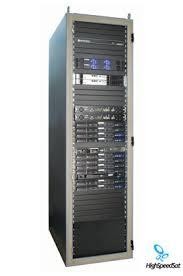
Figure: Equipment of the Network Control Center for a satellite network in geostationary orbit by Hughes Network Systems (USA).
In essence, the NCC is a set of servers connected by fiber-optic communication lines to gateway stations. Communication between the NCC and gateways via optical channels is very important, since it ensures the transmission of NCC information packets to the gateway with a constant delay, which allows you to effectively control the process of transmitting information to the satellite and, most importantly, the process of switching the satellite from one gateway to another, and the terminal between satellites. The use of any communication systems, for example, cellular or wireless, if they have protocols that allow floating delay, is unacceptable here.
According to Elon Musk, the network will use its own proprietary protocol, which will be simpler than IPv6 and have a small header size: "" will be simpler than IPv6 and have tiny packet overhead. " It's also "definitely" going to be a peer-to-peer connection. " Also, the network will use end-to-end traffic encryption:
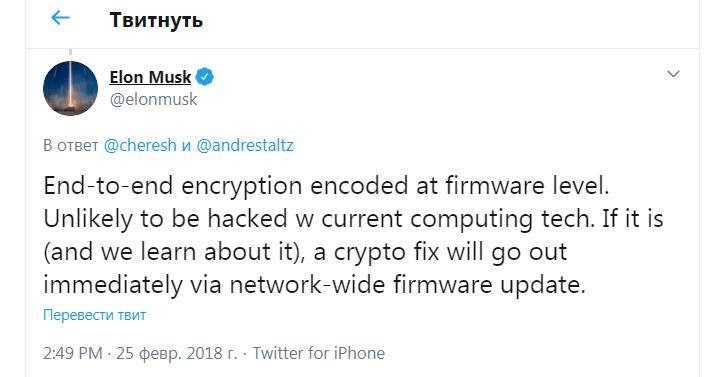
More information about the NCC network of Starlink is now practically unknown.
The ground-based complex for the Control and Collection of Telemetry of the StarLink network can also be referred to the NCC complex.
SpaceX uses 4 stations (teleports), where its own stations of the control and telemetry collection system in Ku and Ka-band are installed.
These are Brewster (Washington state in the USA), Cordova (Argentina), Tromsø (Norway), Avarua (New Zealand). The telemetry and control channel for each satellite can be active for up to 2.5 hours per day (12 minutes per revolution around the Earth) orbit, although the estimated time of telemetry sessions is 60 minutes per day
StarLink teleport parameters
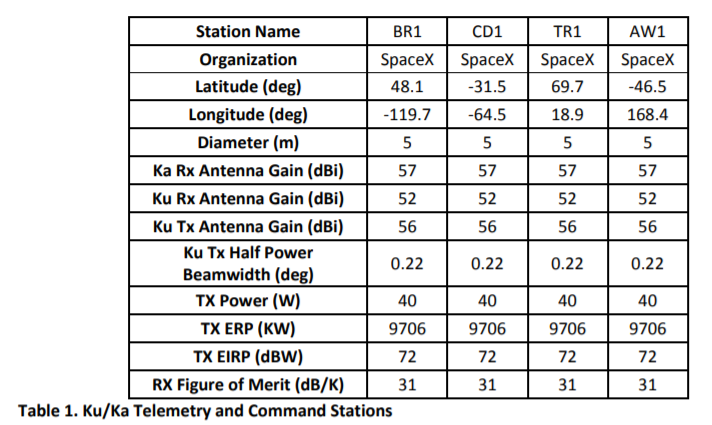
Additionally, Space X has entered into an agreement with the Norwegian operator KSAT to use its worldwide network operating in the X and S bands. Space X will be able to use the entire KSAT terrestrial network, consisting of stations around the world, including Tromsø (Norway), Svalbard (Norway ), Antarctica, Singapore, South Africa, Dubai and Mauritius. The same global network is widely used for flights of Falcon 9 launch vehicles and the Dragon SpaceX spacecraft. SpaceX also created its own tracking and monitoring station in Washington state (index ("RED1"), which should carry the main load, and use the KSAT network if necessary.
Communication sessions in the S- or X-band can last up to 2.5 hours day (or 10 minutes on each loop), although the calculated value is 60 minutes a day.
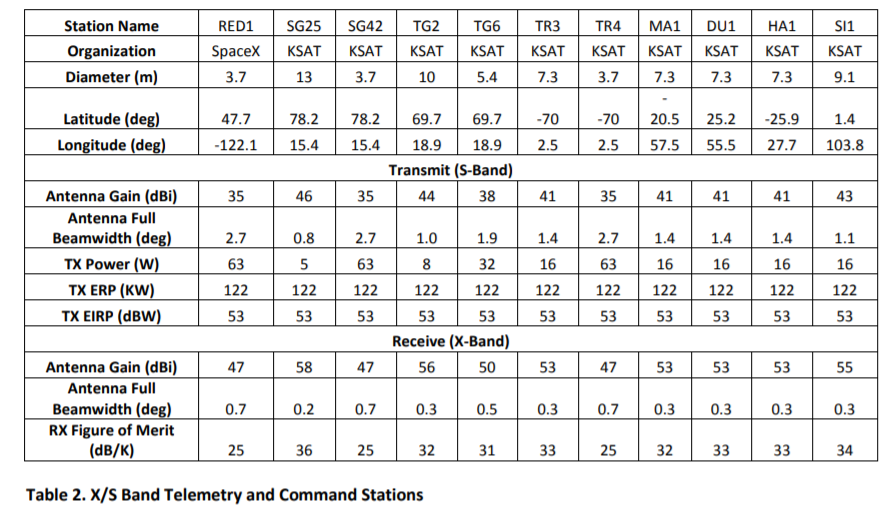
SpaceX also formed a network of test stations to test the service in the StarLink network.
Ground test stations include six fixed earth stations and three mobile ground stations. Their addresses:
- SpaceX Headquarters: Hawthorne, California.
- Tesla Motors Headquarters: Fremont, California.
- SpaceX Test Center: McGregor, TX.
- SpaceX Brownsville: Brownsville, TX
- SpaceX Redmond: Redmond, Washington
- SpaceX Brewster: Brewster, Washington.
- SpaceX Broadband Test Van 1: Portable
- SpaceX Broadband Test Van 2: Portable
- SpaceX Broadband Test Van 3: Portable
It was planned that during the testing period, the satellites would transmit only over these ground stations (elevation angle from 40 ° to 90 °), which corresponds to a session of approximately 10 minutes every day.
Each ground station is equipped with from one to four phased antenna arrays and / or parabolic antennas with the following characteristics
. Also, for this purpose, telemetry and Ku-band antennas can be used.
Gateway stations (gateways)
Gateway stations (gateways) provide information transmission from the Internet via satellite to subscriber terminals. Thus, in the absence of inter-satellite communication, for the operation of a subscriber terminal, it is necessary that at least one gateway is located in the coverage area of the satellite signal through which the subscriber terminal is currently operating. One gateway can work with hundreds and thousands of subscriber terminals. A typical Starlink network gateway has 8 antennas, each of which can transmit information to its own satellite.
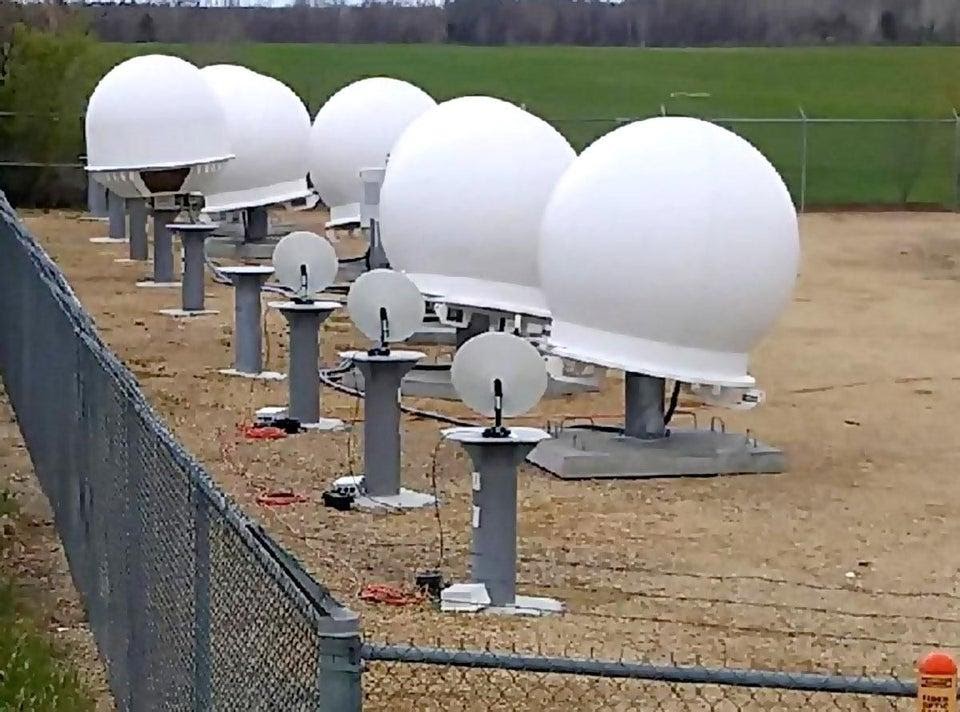
Therefore, a gateway within the Starlink network should be understood as a set of separate antenna posts located in one place and operating in the Ka-band. Usually in the gateway there are also subscriber terminals serving for control purposes: they check on what modulations in given weather conditions the network operates in a given area.
Under the radom (this is the name of the radio-transparent cap) there is something similar to the following antenna:

The gateway must have guaranteed power supply and connection to the backbone of the Internet. At the same time, the subscriber's entry point to the Internet will not be the node of any local provider closest to the gateway, but only SpaceX's own servers, which will have a billing system, client traffic management and SORM equipment (System of Operational Investigation Measures, the American name of a similar law on the obligation of the telecom operator to enable the police to view traffic - Communications Assistance for Law Enforcement Act, abbreviated CALEA).
Since the server requirements for the above services are very high, most likely Starlink will have 4-5 points of entry to the Internet in the United States at the most famous nodes for the exchange of traffic (IX) between ISPs. By the way, this will add a few milliseconds, or maybe a couple of tens of ms to the total network latency.
At the moment, Starlink uses parabolic antennas with a diameter of 1.5 m on its gateways in radoms (radio-transparent domes) of its own production and with a 50 W transmitter. A feature of parabolic antennas is that, unlike phased array antennas, they can operate at low elevation angles (SpaceX's filing indicates up to 5 °).
Here are the specifications of the Gateway (from Space X filing for Japanese telecom regulator)
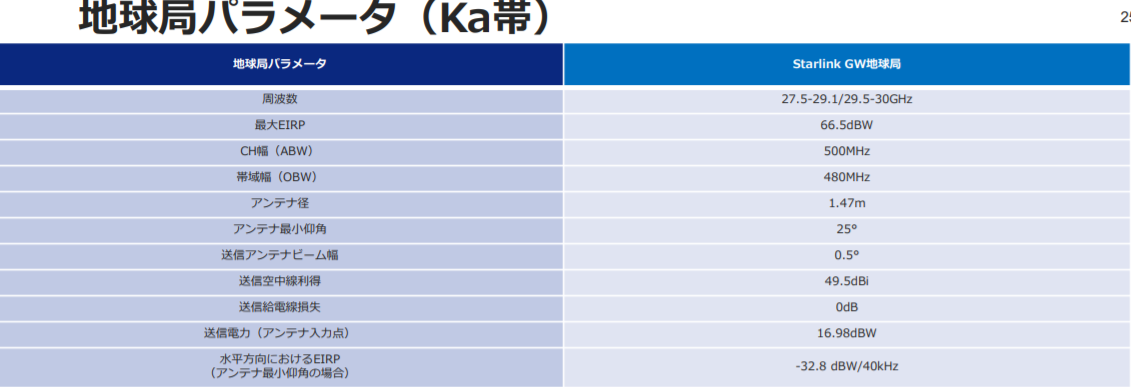
It follows from the table that the terminal operates in a channel with a bandwidth (channel width) of 500 MHz, taking into account the guard intervals of 480 MHz. Antenna diameter 1.47 m, antenna beam angle 0.5 degrees, maximum terminal antenna gain 49.5 dBi, maximum EIRP is 66.5 dBW.
In combination with the fact that the antennas on the satellite for communication with the gateway are also parabolic and have the ability to deviate in the desired direction, this makes it possible to significantly expand the working area of information transmission from the gateway to the satellite.
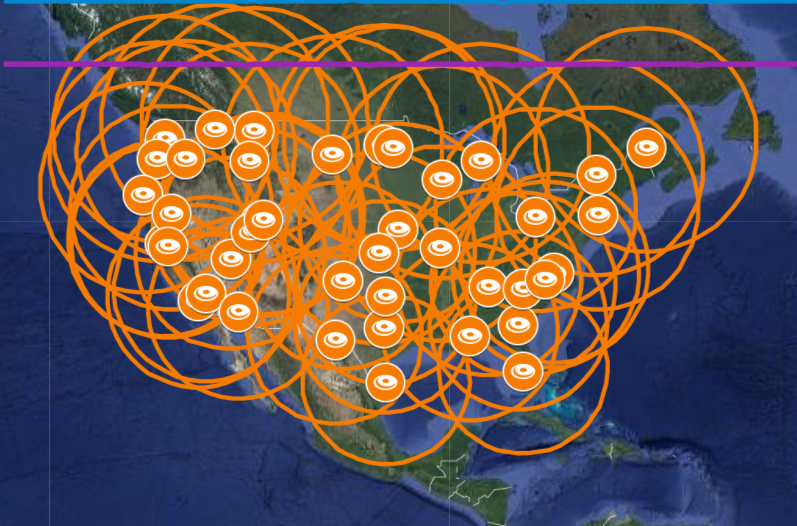
Figure: A map of Starlink gateways in the United States in mid-October 2020 showing their theoretical coverage at an elevation angle of 5-10 degrees.
One of the problems that SpaceX faces when deploying a network of gateways in the United States is that in the United States, part of the Ka-band is assigned to the UMFUS service. The latter acronym is the general term used by the FCC to refer to innovative fixed, mobile and Internet of Things (IoT) services using the 27.5-28.35 GHz Ka-band. The services (or networks) that may be provided by UMFUS licensees are only related to fixed and terrestrial cellular technologies and the fixed satellite service, that is, mobile satellite communications (such as Starlink) are not. Therefore, SpaceX should look in the United States for areas with a very low population density - no more than 450 people in an area where the radiation density (PFD) from the satellite communication antennas of the Starlink gateway is a certain fixed limit of X (-77.6 dBm / m2 / MHz): there, according to the FCC, the Starlink system will not interfere with UMFUS services.
Given that gateways require an open view of the sky and the ability to operate in all 360 degrees and with minimum elevation angles, this condition significantly complicates the process of finding a suitable location for the gateway.
Gateways include modulators and demodulators, which convert the modulated radio signal into a digital data stream and send it to the terrestrial network.
As mentioned above, a single time and a fixed delay in the passage of a packet between the NCC and the gateway plays an absolutely critical role in the Starlink system, so placing gateways on objects moving, even at a minimum speed (for example, floating platforms in the ocean) can be difficult to solve.
Space X offers the following scheme to avoid interference with other satellites in geostationary or low orbit, in contrast to the OneWEB network, where the satellite had to deviate several degrees from the vertical line to Earth, StarLink suggests switching to another Gateway. Here's a diagram from a document sent by Space X to a Japanese regulator.

Red dotted line "The beam is not used, as there is a possibility of interference with other satellites." Green dotted line "Beam can be arranged."
Thus, Space X chose the option of an excessive number of ground gateways in order to be able to select from several gateways for each StarLink satellite, and this also imposes on the Network Management Center the need to constantly calculate the relative position of each StarLink satellite relative to satellites on the GSO, and most difficult all satellites of other operators, which will be placed in other orbits and operating in the selected frequency bands. How the StarLink system will cope with this task in the future, if thousands of Kuiper, OneWEB, TeleSat LEO satellites, Chinese similar systems, as well as other systems using the Ku and Ka bands are launched on the non-GSO, is difficult to assess now, but the task looks very ambitious.
The first information about the placement of Starlink gateways outside the continental United States appeared in October 2020. At the moment, the Australian subsidiary of Space X - Australia PTY LTD has applied to the Australian regulator ASMA for the placement of 4 Gateways, all of them are planned along the southern coast of Australia (along the parallel of 30..40 degrees south latitude).
Previous materials:
- Everything about the Starlink Satellite Internet project. Part 1. Birth of the project
- Everything about the Starlink Satellite Internet project. Part 2. Starlink Network